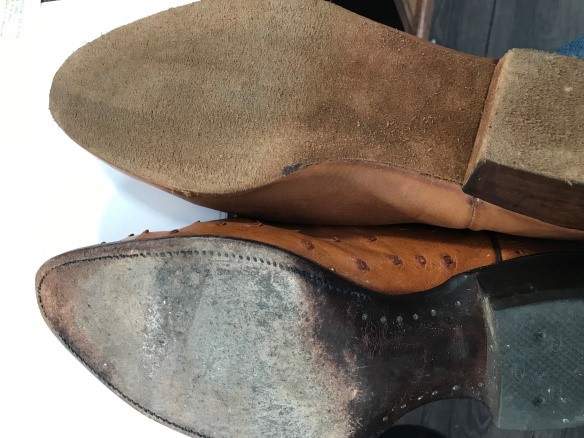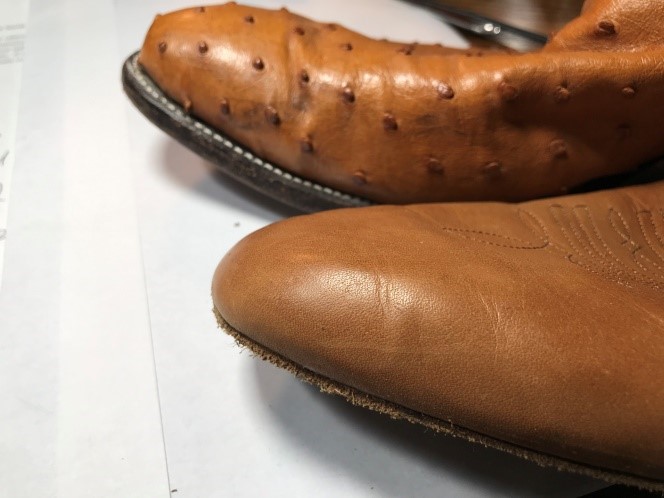Written by John C. Wilson
Although the cowboy boot was most likely used in the very early country dances we’ve come a long way since. At least some of the early roots of country dance began as barn or house dances and as a form of recreation. Likely folks wore what was handy and or what they had. That included boots. But regular cowboy boots aren’t the greatest thing to dance for several reasons. Typically cowboy boots weigh more. They are stiffer and more rigid. The lack of flexibility and sometimes a rubber like sole makes moving around the floor a challenge. So let’s take a closer look at the dance boot and why one should consider the dance boot over the cowboy boot.
Flexibility. Most shoes have a harder, thicker sole. Dance boots and shoes have a very flexible sole that can nearly be bent in half in either direction allowing dancers to really articulate and roll through their feet as they dance. To be specific street shoes and boots are just not very comfortable on the dance floor. Just as street shoes aren’t very comfortable running a marathon!

Traction. The typical street boot has a rubber or leather sole. This makes turning very difficult because they grip the floor and create too much friction. Practically, this can be concern for injury; if one isn’t careful, you could potentially find your body turning without your foot turning and cause damage to your knee. This is why a suede bottom is preferred. The suede bottom offers a perfect combination of slip and grip to keep you comfortably turning without twisting, and gliding without sliding. The suede sole is the standard for dance shoes and dance boots. The suede gives traction for turns as well as sliding across the floor. Most serious dancers will tell you quickly how much they prefer the suede sole. Proper brushing of the suede sole is most important. Although it depends on the floor and how clean it’s kept, suede soles need to be brushed with some kind of brass bristled brush every few hours. Otherwise the suede will revert to smooth leather. When this happens one loses the effect of the suede and has simply a smooth sole.
Weight. The weight of the shoe or boot is always a factor. Some cowboy boots may weigh as much as 4 lbs. Some dance boots may weigh as little as 1.2 lbs. Most dance boots likely average about 2 lbs. The lighter weight is mostly preferred because it is not as tiring to the dancer.
Softness. How stiff or soft the material is another noticeable factor of any shoe of boot. Most manufacturers of dance boots and shoes use a softer more pliable leather. Other materials used frequently in dance boots are Lycra or suede. While the suede may average about the same weight as leather the Lycra is much lighter. Given everything the same the lighter weight is preferred for most dancers. If we choose to dance all night, which very few dancers really ever do, your feet will know the difference the next morning.
Shank. The shank is a part of the supportive structure between the insole and outsole. It’s actually a steel plate that goes from under the heel to just somewhere behind the metatarsal bones of the foot. Most regular boots have a full shank. While the shank provides additional support which may add to the comfort of regular boots most dance boots have either a short shank or no shank. There may be different lengths of the shank to satisfy the preferences of individual dancers. The Competitive dancer will likely prefer no shank to give them the ability to point their toes. This is impossible with the boot with a full shank.

Welt. The welt is a strip of heavy leather that is sewn around the lasting space of the upper and joins it to the insole. The sole is then stitched to the welt with a second seam. Most dance boots do not have the welt. Weltless is sleeker to the contours of the foot. Whether you are a competition dancer or just a social dancer the weltless boot allows more flexibility for movement.
Fit. The general rule is your dance boot or shoe should fit like a glove. The boot should fit as snuggly as is comfortable for your foot. Every individual has a different tolerance for how snug they are comfortable. Keep in mind that every style of boot and shoe fit differently and you should find the style that fits your foot best. Also keep in mind that any boot or shoe molds or conforms to the foot as you break it in. Most people are used to a little extra room in their street shoes, but you want to minimize any extra space in your dance boot or shoes as much as you’re comfortable.
John C. Wilson has a passion for dance shoes! He and his wife Patsy operate Dance Shoes of Tennessee. Look for them at your next dance competition! https://danceshoesoftennessee.com/
